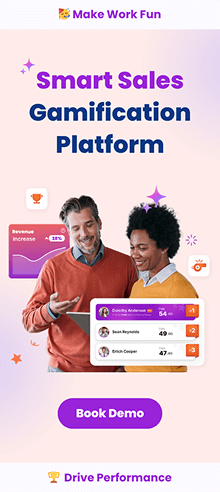Our Rundown of the Best Gamification Software in 2023
In recent years there’s been a surge of interest in gamification, the process of using rewards, challenges, leaderboards, and other game mechanics to drive or improve employee performance, employee motivation, user engagement, or customer loyalty. SaaS reviews platform Capterra lists 234 products in this category, spanning a range of purposes.
What is Gamification?

Put simply, it’s the practice of making a game of any employee or user interaction. Game mechanics are invoked to break down an employee or customer’s natural resistance to handing over personal data, learning, performing routine work, or engaging in other rote activities.
Gamification triggers the same dopamine hits we get when playing our favorite games or scrolling social media for likes and shares. It can even prove benignly addictive, driving participants back for more. In recent years, there has been a surge in the creation of sales gamification and other game-based tools for employee and customer engagement.
A 2022 article in Forbes Magazine describes gamification as “tapping into the video game genius involves transforming your idea, software or product into a resource that doesn’t simply teach — it deeply engages the mind and senses” Multiple elements within this description warrant unpacking.
Firstly, there are the video game mechanics, such as badges or loyalty stamp collection, or the achievement of predetermined goals, business objectives, or metrics. These are common markers of success that many sales enablement platforms feature.
Also central is the notion of user engagement. Training and development prove much more effective when participants are fully engaged and can see their progress graphically represented.
Likewise, competition within a sales team can be strengthened when sales reps can directly compare performance on a leaderboard. That’s the most traditional and tried-and-tested aspect of sales gamification.
Sales or customer gamification provides these rewards while underscoring the value of each gain. When gamification is used, participants are not directly conscious of the engagement process. Subjectively, they are just playing games.
Gamification – Here’s the Science
Elearning Industry explained in a white paper that gamification uses the participant’s brain’s endorphin release mechanism. Endorphins are pleasure-producing hormones that limit pain response during exercise.
Endorphins are triggered in response to effort, both physical and mental. In turn, this causes dopamine release, whose effects are strengthened by enjoyable stimuli, such as the rewards and prizes that gamification offers.
When we put in the effort, we are rewarded with the dopamine hit accompanying achievement. With gamification, we also get the tangible rewards of commendations, prizes, and rewards.
Popular Uses of Gamification

Gamification can be used to make e-learning more effective. It can optimize the performance of sales teams. It can also reward customer loyalty and encourage retention. Any action in which regular effort delivers monetary awards, rewards, tokens, or badges, uses gamification mechanics.
The most common professional uses of gamification software are:
- As a learning tool or training software to ensure information retention.
- To accelerate sales by promoting benign competition.
- To make presentations more interactive and compelling.
- To build user engagement and customer loyalty with rewards and offers.
Given gamification’s flexibility, it’s unsurprising that SaaS providers create a bewildering array of gamification tools. In this rundown, we’ll examine the 22 top-rated best gamification software apps, their key features, and what they can do for your business.
Spinify rates number one on Capterra’s listing, so we’ll begin there.
Top Sales Gamification Tools
1: Spinify
More than a real-time, interactive leaderboard platform (although it is that, too), Spinify is a suite of gamification tools to engender a spirit of competitiveness across your team. Whether accruing points, collecting badges, or climbing the leaderboard, there are many ways to demonstrate ability and celebrate success.
Managers can set targets and leverage the addictive appeal of games where players collect points and rewards. Leaders can show appreciation at the moment by playing a rep’s song, sending a personalized message (publicly), or ringing a virtual gong.
There are all sorts of added extras, like motivational tips and personalized memes, to add novelty to individual dashboards and an intuitive user interface.
Spinify leverages competitiveness between teams and individuals and does so in a fun, addictive way, using the most up-to-date gamification mechanics. After using it, clients show an average of 92% improvement in leaderboard scores.
On Capterra, Spinify boasts over 200 reviews and a 4.5-star rating. Find out more here.
2: Rallyware
Rallyware describes what it does as “performance enablement,” They clearly have a scalable product, with big brand names on board, including Samsung, Vonage, the Body Shop, and Avon. Their product targets distributed or hybrid teams, especially with a slick appearance on mobile devices.
Rallyware is especially strong during sales executives’ onboarding and early training phase, with numerous webinars and certificates of achievement built-in. The learning platform is customizable, but there’s no in-person aspect, and individual reps can’t personalize dashboards.
Progress reporting on trainees is straightforward, and training plans can be tailored readily to individuals. Plus, Rallyware’s service personnel are reportedly very helpful.
3: Alvaria Motivate Mobile
Alvaria has created a sales gamification software platform designed for call centers. It allows for sports tournament-styled knockouts and one-to-one “friends’ duels,” intended to create a spirit of heady competition.
There’s also considerable support for sales training and coaching. The product is aimed at large-scale enterprise businesses and combines fun, interactive leaderboards with onboarding features.
Regarding rewards, there’s an e-gift card scheme, an “auction house” where employees can bid on prizes, and a raffle wheel, where tickets won for employee performance can be exchanged for randomly selected prizes.
“Mobile” refers to the platform’s exclusively cloud-based nature rather than its being usable on mobile devices. While the platform is still relatively new, it has all the features you’d need to motivate a large call, center-based team.
4: EngageBay
For small businesses that can’t afford to invest in a large tech stack of very specialized tools, EngageBay could be a useful platform. It’s part CRM, part marketing, and part sales platform.
Beyond focusing specifically on gamification, it tries to make approaching and marketing to leads as fun and straightforward as possible. In other words, motivate staff by removing the obstacles they face in their work.
5: Engagedly
Using a businesslike approach to goal management and employee engagement, Engagedly claims an average 90% improvement rate.
Unlike some platforms here, it works on mobile devices, making this a good choice for remote or home-working sales reps, allowing them to keep up to date with their targets (and their colleagues’ achievements) while out of the office.
OKRs (objectives and key results) are supported, as well as KPIs, giving employers flexibility regarding how they score employee performance.
Gamification tools include goal setting, award badges, and a social platform where sales reps can compare notes. However, Engagedly is a little light on the quirky fun available on competing platforms. Some of their large corporate clients, including Deloitte, Brinks, and Politico, reflect the stats-driven approach.
6: Bravo
Bravo leverages the power of AI to identify excellent sales performance and reward it in a range of lighthearted ways. Squarely aimed at millennials and Gen-Z sales teams, Bravo awards instant points for achieving large, medium, and small goals.
This creates a constant recognition flow, triggering that game-related dopamine hit we all seek.
Points can then be traded for goods from a range of top brands, including Nike, Apple, Home Depot, and Amazon.
Social and employee recognition is the other strand of Bravo’s offering, including celebrating new hires, anniversaries, and birthdays. Bravo could be a strong contender if you create a collegiate feel in your workplace and have a younger workforce.
Top Learning Gamification Tools
7: Kahoot!
One of the leading providers of adult and children’s online learning, Kahoot aims to make learning fun and lasting. The product is divided into school, home, and work strands. It’s a platform for creating interactive, multi-player learning games and sharing them with invited players who can join via mobile devices.
Kahoot! is nothing if not popular, with over 1 BILLION players per year and uptake by more than half of US teachers. They also claim to have been used by 97% of all Fortune 500 companies. For quizzes, they’re the industry leader. There’s even official Marvel-branded content for kids.
Kahoot! might be a little simplistic for adult employee engagement since it contains only a few customization options, and game mechanics are limited in formatting.
Other business apps may prove more appropriate for ongoing employee training and performance management. However, this could be perfect for refreshing sales team skills, onboarding, or running spot quizzes.
8: Adobe Learning Manager
The design giant has branched out with its own learning platform, formerly Captivate Prime, which plugs into other Adobe tools, including its Experience Manager, for content creation.
Designed to work at scale over distributed sales teams, ALM uses an AI recommendation engine to select learning modules to suit each worker based on their preferences and other performance metrics.
Adopters pay for the established ecosystem they buy into, so this may not suit SMBs; there’s a readymade content library to draw from and many options for customization. However, the platform has been criticized for its lack of tracking features giving managers an overview of how employees engage with their training.
Badges and points are awarded for completion and high scores, but there aren’t many novel gamification features. This product might suit a design and communication-centered business at scale more than a boutique brand.
9: Litmos
Historically, Litmos has proven a popular choice within LMS applications. Users have appreciated its multi-OS functionality and the ability to upload video content as a part of online training programs.
Scoring and evaluation functions for managers are described as transparent and easy to use. Onboarding of new staff works well, and since it’s cloud-based, it’s easy to scale up usage across an organization.
However, a recent change of ownership has produced some grumbles about poor support and a lack of intuitiveness for new employees. A built-in training “dojo” picks up some of the slack, as does the product’s support forums.
Gamification is limited to a friendly leaderboard. However, so other ways to motivate staff may need to be found. Customization is limited, but the platform represents good value for money at its current price bracket.
10: Axonify
Axonify describes itself as an “employee enablement platform,” sitting somewhere between an LMS and a gamified incentive tool. It’s used by large retailers (Walmart, Levi’s) and major corporations (BT, Etihad).
It promotes a culture of continuous training and development and improves employee motivation by focusing on communication and task ownership.
The look and feel of Axonify are more corporate than some incentivization platforms. It is best suited to enterprise businesses that are highly distributed, including shift-based, frontline industries like call centers and hospitality.
Axonify’s gamification tools are slight, with more of a focus on training and development than competitiveness. In truth, it’s perhaps a little old-fashioned in an era of Twitch and TikTok.
Axonify could be used alongside a sales tool and has broader applications as an intelligent LMS.
11: keelearning
Keelearning is a German-based company specializing in educational provision via mobile devices. Aimed squarely at SMBs, it includes a helpful auto-translate facility so that training can be provided in a variety of languages.
Using the functionality of mobile devices at their best, personalized content and push notifications can be sent to individuals, with feedback delivered instantly. In fact, feedback extends helpfully to the content creators too, who can receive reports on how well-received their training courses are.
A language-fluid system like keelearning could be a worthwhile investment if your company is truly global. For English-centric companies, there may be better-suited and more flexible solutions elsewhere.
12: LemonadeLXP
Lemonade LXP’s happy lemon logo lets users know this won’t be another po-faced corporate e-learning system! This is surprising since the company targets businesses in the financial sector, specifically those with 500 or more employees.
LemonadeLXP strikes a delicate balance between providing employees with voluntary courses they’ll want to complete and offering reporting functions for mandatory compliance with corporate training.
Admins find it easy to generate courses, and users report a fun and engaging learning experience, which comes with a popular leaderboard, showing that workplace learning can be competitive too.
Customization options may be a little limited, but functionality scores highly, and very few users report technical difficulties. The platform is a good bet for enterprise companies where there’s a lot of mandatory information to absorb and where CPD is vital.
13: Quizizz
As its name suggests, this tool is for creating interactive quizzes and presentations, which can be accessed anywhere at any time. Aimed at both schools and workplaces, the company’s motto is “where motivation meets mastery,” which neatly encapsulates the ethos of this Indian company.
The quizzes created allow for a range of interaction styles, from circling elements on a graphic to moving image blocks into place. These methods of answering make a pleasant change from text-based LMS platforms, and Quizizz has plenty of pre-programmed variations so course devisers can easily slot in content.
Many schools in the UK use Quizziz, and it’s easy to see why – learning becomes fast and fun. Whether this approach works as well in a corporate environment is another question. However, Quizizz does include a points-based leaderboard and over 50,000 corporate clients, including Amazon, Audi, and Virgin Media.
14: QuizHub
Aimed at increasing user engagement during presentations and events, QuizHub wants to make the conference experience more interactive.
It has many e-learning gamification features you’d expect from a motivational tool, including certificates and quizzes and the ability to create tournaments. This latter feature makes it an excellent choice for IT brands wanting to leverage that “hackathon” vibe.
Quizzes can have up to 500 players for live-streamed events, and access by Q-code is supported. Events can be scheduled, and your branding can fully customize host pages. Teams can compete against one another too. As well as top scores, users can compete for cool t-shirts and cash prizes.
One for the tech nerds!
15. Opendo app
Another tool for making presentations and events more dynamic, Opendo lets you create polls, quizzes, interactive whiteboards, and other items which allow remote participants to contribute to the conversation.
The French company’s offering includes seventeen different kinds of interaction, and the monthly fee is very reasonable. It’s one of the most cost-effective solutions on the market. Their first language is French, so that support may be limited.
One downside is that participants must download the app onto their phones, which may cause some hesitancy. It only exists as an app at present, although it is available in six languages, and its basic form is free to download.
16: TalentCards
A virtual flashcard-based learning system, TalentCards turns your mobile device into a cheat sheet on any topic. Also available on a desktop, the platform allows trainers to create card sets and then share them with unique sets of users. This makes TalentCards an excellent platform for heavily distributed sales teams, such as reps in the field.
Quizzes, polls, and surveys are enabled, as are links to YouTube videos, and push notifications can be sent when new content is available. The flashcard-based functionality encourages a “micro-learning” approach, where participants ingest and retain learning in bite-sized chunks.
Users have reported limited customization options for quizzes and a clunky admin interface, but overall, this is a highly intuitive and popular platform for highly distributed workforces.
Top Customer Engagement and Loyalty Tools
17: Talon One
Striking a corporate note, Talon One promises “sales promotions and promotions” using what it describes as gamification. In reality, it’s a marketing tool allowing you to create customer loyalty schemes, discount codes, coupons, and other items of marketing automation to pull in customers.
One fun feature is the ability to geo-fence campaigns so you could create an in-store promotion or restrict an offer to a specific city or cities (for instance). Targeting can be highly personalized and customized so that you can focus on specific campaigns for greater effectiveness.
Bringing some of the rewards of advanced gamification platforms, Talon One makes the business processes of pricing and discount coding more fun. Talon One has big-name clients, including Eddie Bauer, ZipCar, National Express, and Elsevier.
18: Qualifio
Gaming engagement to gain first-party data in the era of GDPR and the removal of cookies from key browsers makes Qualifio a timely purchase. Some major CPG brands, including Nestle and PepsiCo, use this platform, so it’s priced at a premium.
What Qualifio permits may make the expenditure worthwhile, however. Brands can create interactive games, polls, surveys, and quizzes which invite those all-important email addresses and phone numbers, allowing you to follow up with sales and marketing campaigns.
Users rave about the ease with which they can build a brand community, build loyalty, and link to customers’ own social media accounts. Integration with CRM platforms and support features score highly too.
If you’re a large-scale enterprise business looking to build customer engagement, Qualifo might be the bag of tricks you need.
19: Kangaroo
Kangaroo brings advanced gamification to the customer engagement experience, offering a branded rewards platform to encourage customer loyalty and repeat business. Including instant discounts, rewards, and game mechanics like “spin to win.”
Kangaroo is designed for mobile devices for maximum market penetration. It supports geo-fenced offers for in-store experiences and allows brands to create customer loyalty tiers to encourage spending.
Kangaroo scores high across the board, with reputedly excellent customer service. Users can log in using their phone number, which allows them to send push notifications and SMS alerts with seasonal offers.
Since interactivity is the 21st-century experience shoppers are growing to expect, it pays to gamify customer loyalty, and Kangaroo is an ideal platform on which to do so.
Customer behavioral tracking may be limited at present, and there’s a learning curve, but the company is very proactive in offering support.
Miscellaneous Gamification Tools
20: Optimity
Optimity brings the cloud-based gamification platform to well-being. Users can build personal goals in exercise, sleep, nutrition, mental health, social connectedness, and financial wellness. Think of it as a kind of life coach in your pocket, albeit one you’ve pre-programmed yourself.
Friendly and healthy competition with wellness partners is encouraged, and a slew of content is included for self-education on all things related to well-being. Somehow, Optimity strikes the right balance between providing a gentle nudge and not seeming like that smug, health-conscious friend we can never live up to.
Each healthy step you take is rewarded with points you can later exchange for brand rewards, charitable donations, and weekly raffle tickets. Don’t expect to win cakes or champagne, however!
Aimed at all age groups and customizable for each life stage, Optimity could be an excellent app to purchase for your employees or encourage them to download to improve their overall health and performance. Many people already have a diet tracker, an exercise app, and a mindfulness tool on their phones – this combines everything in one place.
Spinify for Motivation, Excellence, and Unity
We hope this rundown of gamification software has been helpful. It’s an ever-growing field, so we’ll likely have to renew this list annually.
Okay, we’re biased, but we’ve created the very best sales gamification platform (and our top placement on review sites backs that up). Our clients want to build engagement, drive their employees to higher peaks of success, and receive all the vital performance metrics they need.
At Spinify, we strike a balance between gameplay and performance monitoring. It isn’t just fun and games; there’s plenty of data. We’ve created Spinify to help you turn your workforce into a motivated, happy, high-performing sales team.
Book a demo today, or visit our gamification software product page.



